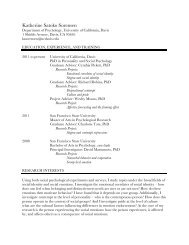The Psychology of Creativity:
The Psychology of Creativity:
The Psychology of Creativity:
You also want an ePaper? Increase the reach of your titles
YUMPU automatically turns print PDFs into web optimized ePapers that Google loves.
History <strong>of</strong> <strong>Creativity</strong> Research 28<br />
Martindale, C. (1999). Biological bases <strong>of</strong> creativity. In R. J. Sternberg (Ed.), Handbook <strong>of</strong> creativity (pp. 137-152).<br />
Cambridge: Cambridge University Press.<br />
Maslow, A. H. (1959). <strong>Creativity</strong> in self-actualizating people. In H. H. Anderson (Ed.), <strong>Creativity</strong> and its cultivation<br />
(pp. 83-95). New York: Harper & Row.<br />
May, R. (1975). <strong>The</strong> courage to create. New York: Norton.<br />
Mednick, S. A. (1962). <strong>The</strong> associative basis <strong>of</strong> the creative process. Psychological Review, 69, 220-232.<br />
Miller, G. F. (1997). Protean primates: <strong>The</strong> evolution <strong>of</strong> adaptive unpredictability in competition and courtship. In<br />
A. Whiten & R. Byrne (Eds.), Machiavellian intelligence II (pp. 312-340). Cambridge, England:<br />
Cambridge University Press.<br />
Miller, G. F. (1998). How mate choice shaped human nature: A review <strong>of</strong> sexual selection and human evolution. In<br />
C. B. Crawford & D. Krebs (Eds.), Handbook <strong>of</strong> evolutionary psychology: Ideas, issues, and applications<br />
(pp. 87-129). Mahwah, NJ: Erlbaum.<br />
Miller, G. (2000). <strong>The</strong> mating mind: How sexual choice shaped the evolution <strong>of</strong> human nature. New York:<br />
Doubleday.<br />
Murray, P. (Ed.). (1989). Genius: <strong>The</strong> history <strong>of</strong> an idea. Oxford: Blackwell.<br />
Newell, A., Shaw, J. C., & Simon, H. A. (1958). Elements <strong>of</strong> a theory <strong>of</strong> human problem solving. Psychological<br />
Review, 65, 151-166.<br />
Newell, A., & Simon, H. A. (1972). Human problem solving. Englewood Cliffs, NJ: Prentice-Hall.<br />
Nicholls, J. G. (1972). <strong>Creativity</strong> in the person who will never produce anything original and useful: <strong>The</strong> concept <strong>of</strong><br />
creativity as a normally distributed trait. American Psychologist, 27, 717-727.<br />
Nickerson, R. S. (1999). Enhancing creativity. In R. J. Sternberg (Ed.), Handbook <strong>of</strong> creativity (pp. 392-430).<br />
Cambridge: Cambridge University Press.<br />
Ortega y Gasset, J. (1957). <strong>The</strong> revolt <strong>of</strong> the masses (M. Adams, Trans.). New York: Norton. (Original work<br />
published 1932)<br />
Plucker, J. A., & Dana, R. Q. (1999). Drugs and creativity. In M. A. Runco & S. Pritzker (Eds.), Encyclopedia <strong>of</strong><br />
creativity (Vol. 1, pp. 607-611). San Diego: Academic Press.<br />
Qin, Y., & Simon, H. A. (1990). Laboratory replication <strong>of</strong> scientific discovery processes. Cognitive Science, 14,<br />
281-312.
















